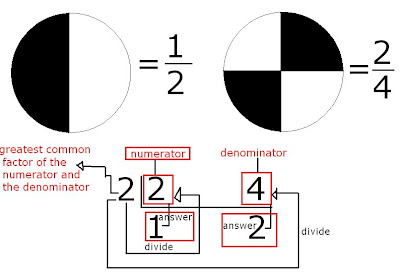Equivalent
fractions
Equivalent fractions >> are fractions that have the same value or represent the same part of an object.
example: If a pie is cut into two pieces, each piece is also one-half of the pie. If a pie is cut into 4 pieces, then two pieces represent the same amount of pie that 1/2 did. 1/2 is equal to 2/4 because 1/2 is the lowest term of 2/4, and when you crossed multiply 1/2 and 2/4, they have the same product.
I used continuous division in getting the lowest term of 2/4...
you can also cross multiply the fractions to know if the fractions are equivalent...
or you can get their decimal to know if the fractions are equivalent...
well that's all i know about equivalent fraction... hope you understand my explanations.. =D
just comment if you have questions or if i did something wrong in my super scribe... ok??
-rivka cabalquinto 8-17













